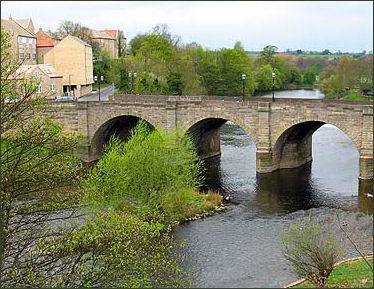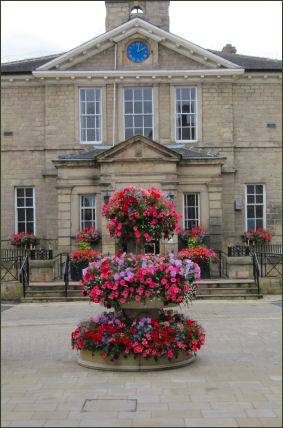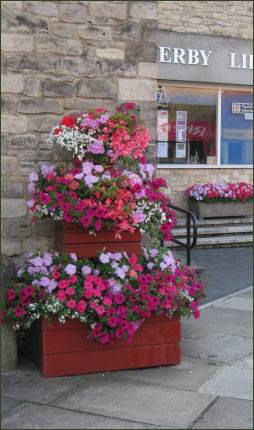Wetherby
OS grid reference:- SE 404 481
 The historic market town of Wetherby, an award winning floral town, stands on the River Wharfe, which forms part of the boundary between West and North Yorkshire. Wetherby is located 8 miles south east of Harrogate and 12 miles the north east of the city of Leeds.
The historic market town of Wetherby, an award winning floral town, stands on the River Wharfe, which forms part of the boundary between West and North Yorkshire. Wetherby is located 8 miles south east of Harrogate and 12 miles the north east of the city of Leeds.
 A town of ancient origins, Wetherby has seen human habitation from at least Neolithic times, it was also an important Roman site. Wetherby is mentioned in the Domesday Survey of 1086 where it is referred to as Wedrebi, the name is believed to derive from wether- or ram-farm or alternatively, may mean "settlement on the bend of a river".
A town of ancient origins, Wetherby has seen human habitation from at least Neolithic times, it was also an important Roman site. Wetherby is mentioned in the Domesday Survey of 1086 where it is referred to as Wedrebi, the name is believed to derive from wether- or ram-farm or alternatively, may mean "settlement on the bend of a river".
Wetherby Bridge (pictured right), a Scheduled Ancient Monument, spans the River Wharfe. Just upstream from the bridge is the weir which was restored in the early 1980s. The route of the Old Great North Road passes through Wetherby which has for centuries been a crossing place and staging post on the road, being situated mid-way between London and Edinburgh. Consequently a large number of coaching inns were established in the town which are still used by visitors today. At the heyday of the coaching era, Wetherby had up to forty inns and alehouses. The first recorded mail coach arrived in the town in 1786.
The chivalric orders of Knights Templar and later the Knights Hospitallers were granted land and properties in Yorkshire in the twelfth and thirteenth centuries. The local preceptory founded in 1217 was at Ribston Park. In 1240 the Knights Templar were granted by Royal Charter, issued by King Henry III, granting the right to hold a market in Wetherby.
From 1318 to 1319 the North of England suffered badly from frequent raids from the Scots. Following the Battle of Bannockburn in 1314, a renowned Scottish victory where Robert the Bruce triumphed over King Edward II, Wetherby was burned and pillaged and many of the town's population taken and slaughtered. Scott Lane may be named after the Scottish raiders in 1318 or alternatively, the eighteenth century drovers who used Wetherby as a stopping place.
 In 1644 during English Civil War between Parliament and the ill fated King Charles I, the Parliamentarian army, prior to marching to Tadcaster and on to do battle with the Royalists at Marston Moor, were stationed two days in Wetherby, joining forces with the Scots. Oliver Cromwell probably spent the night after the battle of Marston Moor at the 'Half Moon Inn' at Collingham, 3 miles from the town.
In 1644 during English Civil War between Parliament and the ill fated King Charles I, the Parliamentarian army, prior to marching to Tadcaster and on to do battle with the Royalists at Marston Moor, were stationed two days in Wetherby, joining forces with the Scots. Oliver Cromwell probably spent the night after the battle of Marston Moor at the 'Half Moon Inn' at Collingham, 3 miles from the town.
Wetherby Town Hall (pictured above right) is situated in the centre of the market square and replaced the former Court House and Wetherby Prison.
The Shambles was built in 1811 by the Duke of Devonshire as ten butcher shops, which only opened on market day. In 1888 these were converted to a covered market where farmers bought their produce. The present facade was added early in the nineteenth century. Today the Shambles boasts specialist craft shops, quaint tearooms and restaurants.
The Huguenot Arch near Wetherby Library was originally a passageway between two houses at Westgate. Tradition relates that the houses were probably built by the descendants of Huguenot refugees from France. The inscription is in French and translates as 'Love your neighbour as yourself, said the Evangelist'. It was laid on the 19th January 1827.
The town offers good riverside walks and picnic areas and a free car park by the riverside Bandstand. The town centre is full of interesting small shops selling a wide variety of goods There are also many tea/coffee shops and restaurants. The narrow town centre streets are lined with a good selection of independent boutique shops.
A Historical Trail leads through the town centre and provides an interesting insight into Wetherby's past. Leaflets on the Trail are available in shops and the Library. Wetherby Racecourse holds popular steeplechases as well as exhibitions and arts, crafts and antique fairs.
The 'Wetherby in Bloom' committee was set up in 1989, the town won the Entente Florale gold award in 1999 and an International Communities in Bloom award in 2005. It achieved success in the RHS Britain in Bloom competition in 1998, 2002 and 2010, along with numerous regional gold awards over the last 15 years. The annual Wetherby Festival promotes the arts by providing a platform for local groups to perform and to bring in other performers and art forms.
Nearby Stockeld Park lies just 3 miles to the North West of the town and is located on the A661 between Harrogate and Leeds. The Palladian villa was designed for William Middleton, a prominent local Catholic gentleman, by architect James Paine. The Palladian villa was designed for William Middleton, a prominent local Catholic gentleman, by architect James Paine. The building was completed in 1763.
Towns and Villages of Yorkshire
